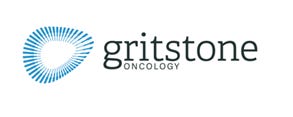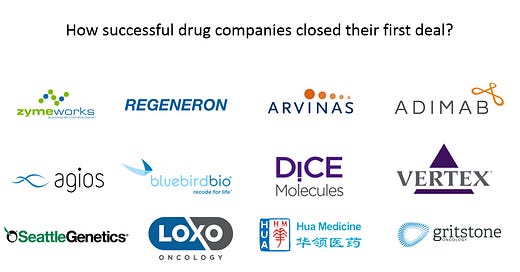Drugs
Zymeworks
Strategy: Bringing a validated protein engineering platform to a large biopharma in crisis.
In 2011, Zymeworks struck their first deal with Merck. Founded in 2004, Zymeworks originally was pursuing industrial enzymes and validated its protein engineering platform in this field. However, like all great founders, Ali Tehrani shifted toward a more promising market - new medicines not wanting to build a “coffee shop” Given the technical progress, Zymeworks was well positioned to close a biopharma deal. Merck was coming off a string of failures, 2011 was well before Keytruda was approved and became one of history’s best selling medicines, and was looking to restock its pipeline. Kind of similar to Gilead right now. Merck was an active dealmaker with expertise in clinical development but was falling behind in protein engineering. Zymeworks was an early-stage business looking for validation to raise their next round of financing. Zymeworks had a BD process ongoing and found a match with Merck to run up to 3 programs with Zymework’s Azymetric (bispecifics) and EFECT (enhancing control) platforms. Zymeworks and Merck expanded the deal in 2014 with Zymeworks receiving $4.75M to date with milestones up to $186M and single-to-mid digit royalties on the programs. This first deal set the basis for Zymeworks to raise more capital and validate its work to internally develop their own medicines and close deals with companies from Johnson & Johnson to GSK. Early on, Zymeworks had ambitions to match a peer, Applied Molecular Evolution which was sold to Eli Lilly for $400M in 2004. Led by a great founder and validating their technology early on to close deals and get to the clinic themselves, Zymeworks is worth well over a $1B with a lot of room to grow.
Regeneron
Strategy: Pioneering the 50/50 deal.
In 2006, Regeneron completed a deal with Bayer to develop a new medicine for neovascular age-related macular degeneration (wet AMD). This program led to the approval of Eylea - Regeneron’s flagship product. Although Regeneron had done a few deals over the years, the deal with Bayer was the first for the revamped (nearly took a decade) Regeneron that was focused on translating its Trap technology. At the time Regeneron had been validating its Trap technology that came out of its original neutrophic factor programs. Regeneron needed more capital to develop a promising drug for wet AMD. Luckily, Leonard Schleifer (co-founder and CEO) is one of the best deal-makers in biotechnology, he helped pioneer the 50/50 deal in the field. To get Bayer on board as a co-developer, Leonard made a deal with Bayer for distribution outside of the US ex-Japan sharing 50% of the total development costs for Eylea. This moved a promising medicine forward that has become a major success for Regeneron and set up the company to strike more deals in particular with Sanofi.
Arvinas
Strategy: Working with a biopharma with an appetite for new technologies to reduce market risk of a new modality.
In 2015, Arvinas partnered up with Merck. With its win at its back now with Keytruda approved for its first indication, Merck was in the mood to take more scientific risk and explore new modalities to ensure it keeps its lead. Arvinas and its founder, Craig Crews pioneered PROTACs to selectively degrade protein targets to pursue the undruggable genome. Founded in 2013 and based on over a decade’s worth of research, Arvinas had validated its technology. The company also had a few internal programs at the time and sought out partnership from Merck to gain market validation - it’s “a signal for others we've talked to that perhaps a deeper dive may be warranted.” The deal with Merck reduced market risk for degraders as a modality, helped Arvinas raise more capital and go public and close a few other partnerships along the way to be the first company to bring degraders to the clinic.
Adimab

Strategy: Solving an IP problem in drug development to license out new antibodies.
In 2009, Adimab entered into a deal with both Merck and Roche. At the time, large biopharma were limited in their ability for humanized antibody discovery due to IP conflicts. Adimab solved this problem, which allowed them to strike two large deals within 2 years of founding to license its yeast-based platform for humanized IgG monoclonal antibodies. At the announcement of the deals, Tillman Gerngross (CEO and co-founder) credited the success to Adimab’s “disruptive technology in the antibody discovery space.” Even more disruptive was the business model they validated by designing unique deal structures with various upfront payments, preclinical milestones, and licensing fees for its antibody discovery engine.
Agios

Strategy: Generating excited within the scientific community around targeting cancer metabolism.
In 2010, Agios did a deal with Celgene to partner up its cancer metabolism work for a $130M upfront payments, equity investment, and co-development rights. Ultimately, this deal led to the approval of Idhifa in 2017 for relapsed/refractory AML. Agios was founded on the premise of specifically targeting cancer metabolism in particular two dehydrogenases, IDH1/2. With the backdrop of publishing an exciting paper in Nature and GSK funding more work in cancer metabolism, Celgene felt the pressure or urge to partner up with Agios.
Bluebird Bio

Strategy: Bringing its genetic engineering technology to an emerging CAR-T field.
In 2013, the CAR-T buzz was increasing and Celgene seemingly being left behind in the checkpoint inhibitor space as clinical data from BMS and Merck was coming out partnered with Bluebird Bio. Bluebird actually was founded in 1993 as Genetix, actually a Marvel comic book series, to pursue transplant therapies. In 2010, the company got recapped by Third Rock and renamed Bluebird with Nick Leschly becoming CEO. In 2013, Bluebird had built out various gene therapy technologies for its own adrenoleukodystrophy (ALD) and Beta-Thalassemia programs. On the hunt for an edge in the emerging CAR-T space, Celgene decided to work with Bluebird, who a compelling method to genetically manipulate cells, to develop autologous T-cell therapies. Bluebird received upfronts and potential milestone payments and decided to take a route Regeneron paved the way for by signing a 50/50 development deal.
DiCE Molecules

Strategy: Build libraries of chemical matter at an unprecedented scale for hard targets.
In 2016, Sanofi and DiCE Molecules entered into a 5-year, $50M (upfront and equity) collaboration to use DiCE’s DNA-encoded library technology to find new chemical matter against 12 targets Sanofi provided. Founded in 2014 by a trio of individuals who reunited after doing postdocs at UC Berkeley in the 1990s, DiCE spent ~2 years building up its methods for constructing DNA-encoded libraries by at least an order magnitude larger size than peers with the ability to rapidly iterate/enrich hits through next-generation sequencing. With the selling point that DiCE can build libraries of chemical matter at an unprecedented scale at the time, they convinced Sanofi that they could find valuable chemical matter against hard-to-drug targets that were of interest to the latter. This deal was reliant on DiCE validating its technology early on and finding the right story to sell to biopharma - we build the libraries you can’t built and you provide the targets you’re interested in. This set the basis for DiCE to strike even more deals and grow substantially.
Vertex Pharmaceuticals

Strategy: Get a deal to set terms for future deals for its contrarian rational drug design thesis.
Nineteen ninety-five was a big year - Oasis dropped Champagne Supernova and Vertex got a deal done with Grifols. Vertex was a very unique company at its founding in 1989 where its peers were obsessed with new combinatorial chemistry tools, Vertex took the contrarian position to focus on rational drug design. Similar to the present era, where rules-based systems driven by software could supplant other methods in drug development - time will tell. In 1995, Vertex struck up a deal to develop a molecule, VX-366 (isobutyramide), to treat inherited hemoglobin disorders by reactivating a dormant form of hemoglobin F. The deal was nothing special and was eventually scrapped over a decade later; however, it set the terms for future deals for Vertex’s contrarian strategy. Even though the Grifols deal was not perfect, Vertex negotiated a 30% profit share that set them up to do deals with Bristol, Lilly, and Pfizer later on.
Seattle Genetics

Strategy: Work with the market leader to develop next-generation precision cancer treatments.
In 1999, Seattle Genetics partnered with Genentech to license its antibody-drug conjugate (ADC) technology for a combination of upfronts, equity investment, and royalties. Seattle Genetics was founded in 1998 to build more precise medicines for cancer patients beyond chemotherapy. The key premise for Seattle was improving linker chemistry between a given antibody and its corresponding small molecule payload. ADCs often fail for poor linkers that lead to toxic off-target effects. Genentech was a leader in antibodies and having a lot of success - they were interested in the next frontier of medicines, which seemed to included ADCs. The deal for Seattle allowed them to collect at least $20M in licensing fees alone from Genentech, Protein Design Labs to Celltech.
Loxo Oncology

Strategy: Partner with a large diagnostics company to accelerate their medicine for genetically defined cancers.
In 2017, did their first deal with Ventana Medical Systems (Roche) to develop and commercialized a pan-TRK companion diagnostic test for its own medicine. Technically, Loxo’s first deal was actually itself partnering with Array BioPharma in 2013. The deal with Ventana set Loxo on a path for Loxo’s larotrectinib to get approved in 2018 with some of the most beautiful waterfall plots you will see in drug development. Founded in 2013, Loxo was formed around genetically-informed target selection and developing treatments for genetic targets not just a particular cancer. This deal was lucrative for Roche’s diagnostic business if Loxo got their drug approved (companion diagnostics have been a dud overall) and Loxo had a great partner who has the capacity to commercialize a test to enable clinicians to more precisely prescribe the new medicine. This deal has worked out well for Loxo with the Eli Lilly acquisition and bringing a transformational medicine to market.
Hua Medicine

Strategy: Promise access to new markets to gain promising clinical assets.
In 2011, Hua Medicine and Roche entered into an agreement where Hua licenses Roche’s glucokinase activator (treat diabetes by lowering glucose levels) program to bring to China. There are over 20M diabetes patients in the US and over 4x that number in China, 90M. Hua received global rights to a promising clinical asset for type II diabetes and Roche got a combination of upfront payments, milestones, royalties, and more importantly access to a fast-growing Chinese market. This deal set up Hua to reach its Phase III endpoint recently, and pioneered China/US deals in drug development.
Gritstone Oncology

Strategy: Find the validation half for its target identification platform to enable the company to bring its own medicines to patients.
In 2016, Gritstone struck up a deal with Immune Design to use the latter’s ZVex discovery tool (activate and expand tumor-specific cytotoxic T cells) with Gritstone’s platform to identify patient-specific tumor antigens to develop new immunotherapies. Within one year of its founding, Gritstone needed to fill the other half of its platform - it could find interesting targets but didn’t have the capability to get the cells. By linking up with Immune Design, Gritstone shored up its platform to bring its own internal medicines through the pipeline, go public, and complete partnerships with companies like Bluebird.






